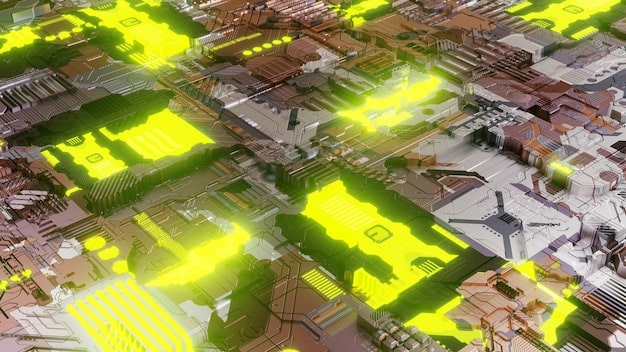Renewable Energy Surge: How 15% Capacity Boost Impacts US Grid Stability

The projected 15% increase in US renewable energy capacity by 2025 introduces both opportunities and challenges for grid stability, demanding innovative solutions to manage intermittency, ensure reliability, and modernize infrastructure.
The United States is on the cusp of a significant transformation in its energy sector, with projections indicating a 15% increase in renewable energy capacity by 2025. This surge in green energy sources like solar, wind, and hydro presents exciting possibilities for reducing carbon emissions and combating climate change, but also raises critical questions about its impact on grid stability.
Understanding the Renewable Energy Landscape in the US
To fully appreciate the potential impact of this growth, it’s essential to understand the current landscape of renewable energy in the United States. The US has been steadily increasing its reliance on renewable sources, driven by factors such as declining costs, technological advancements, and supportive government policies.
Current Renewable Energy Sources
The US energy mix includes a variety of renewable sources, each with its own strengths and challenges. Solar energy is booming, particularly in sunny states like California and Arizona. Wind energy continues to expand, with large wind farms dotting the Great Plains. Hydropower, a more established renewable source, provides a consistent base load in many regions.
- Solar Energy: Rapidly growing due to decreased costs and increased efficiency.
- Wind Energy: Expanding in regions with consistent wind resources.
- Hydropower: A reliable but mature renewable energy source.
- Geothermal Energy: Utilized in specific geological areas for both electricity and heating.
Additionally, geothermal energy and biomass contribute to the renewable energy portfolio, though to a lesser extent than solar, wind, and hydro.

Factors Driving Renewable Energy Growth
Several factors are fueling the projected 15% increase in renewable energy capacity. Government incentives, such as tax credits and renewable portfolio standards, play a significant role. Technological advancements are also making renewable energy more cost-competitive, driving further adoption.
Public awareness and concern about climate change are also contributing to the demand for cleaner energy sources.
In conclusion, the US renewable energy landscape is dynamic and evolving, with a mix of established and emerging technologies contributing to the overall energy supply. The factors driving this growth are expected to continue, paving the way for a substantial increase in renewable energy capacity by 2025.
The Challenge of Intermittency and Grid Stability
One of the primary concerns surrounding the integration of renewable energy sources is their intermittency. Unlike traditional fossil fuel power plants that can operate continuously, solar and wind energy generation fluctuates depending on weather conditions.
Understanding Intermittency
Intermittency refers to the variability and unpredictability of renewable energy sources. Solar energy is only available during daylight hours, and its output can be affected by cloud cover. Wind energy depends on wind speed, which can vary significantly throughout the day and across different seasons.
This intermittency poses a challenge for grid operators, who need to ensure a constant balance between electricity supply and demand. When renewable energy production drops unexpectedly, grid operators must quickly find alternative sources of electricity to prevent power outages.
Impact on Grid Stability
The influx of intermittent renewable energy sources can create instability in the grid. Fluctuations in renewable energy output can lead to voltage and frequency variations, which can damage equipment and disrupt power flow.
- Voltage Fluctuations: Can damage sensitive electronic devices.
- Frequency Variations: Can disrupt the synchronization of generators.
- Curtailment: Sometimes, excess renewable energy must be curtailed (wasted) to maintain grid stability.
Moreover, the integration of renewable energy sources can strain the existing grid infrastructure, which was designed for traditional baseload power plants.
In summary, intermittency is a significant hurdle in the integration of renewable energy sources, requiring innovative solutions to maintain grid stability and reliability.
Modernizing the Grid for Renewable Energy Integration
To accommodate the increasing share of renewable energy, the US needs to modernize its grid infrastructure. This modernization involves upgrading transmission lines, deploying smart grid technologies, and investing in energy storage solutions.
Upgrading Transmission Infrastructure
Many of the best renewable energy resources, such as wind in the Great Plains and solar in the Southwest, are located far from major population centers. This necessitates the construction of new transmission lines to transport electricity from these remote areas to where it is needed.
Upgrading existing transmission lines is also crucial to increase their capacity and reduce congestion. This will allow more renewable energy to flow through the grid without causing bottlenecks.
Smart Grid Technologies
Smart grid technologies can help to improve grid efficiency and reliability by providing real-time monitoring and control capabilities. Smart meters, advanced sensors, and communication networks enable grid operators to better manage electricity flow and respond quickly to changes in supply and demand.
These technologies also facilitate the integration of distributed generation sources, such as rooftop solar panels, into the grid.
Smart grid technologies are essential for optimizing the integration of renewable energy sources, enabling a more flexible and responsive grid.

Energy Storage Solutions
Energy storage solutions, such as batteries and pumped hydro storage, can play a vital role in mitigating the intermittency of renewable energy sources. These technologies can store excess electricity generated during periods of high renewable energy production and release it when demand is high or when renewable energy output is low.
- Battery Storage: Quickly responding to fluctuations in supply and demand.
- Pumped Hydro Storage: Storing large amounts of energy for extended periods.
- Thermal Storage: Storing heat or cold for later use.
The deployment of energy storage solutions is critical for ensuring grid stability and maximizing the use of renewable energy.
In conclusion, modernizing the grid through infrastructure upgrades, smart grid technologies, and energy storage solutions is essential for successfully integrating the increasing share of renewable energy in the US.
The Role of Energy Storage in Balancing the Grid
Energy storage is emerging as a key technology for ensuring grid stability in the face of increasing renewable energy penetration. Energy storage systems, such as batteries, pumped hydro, and thermal storage, can absorb excess energy when renewable generation is high and release it when generation is low.
Types of Energy Storage
Several types of energy storage technologies are available, each with its own characteristics and applications. Battery storage systems are becoming increasingly popular due to their fast response times and declining costs. Pumped hydro storage, a more established technology, can store large amounts of energy for extended periods. Thermal storage systems store energy in the form of heat or cold for later use.
The choice of energy storage technology depends on factors such as the scale of the application, the duration of storage required, and the cost-effectiveness of the technology.
Benefits of Energy Storage
Energy storage offers numerous benefits for grid stability and renewable energy integration. It can smooth out the variability of renewable energy sources, providing a more reliable and predictable supply of electricity. It can also improve grid efficiency by reducing transmission losses and optimizing the use of existing infrastructure.
Furthermore, energy storage can enhance grid resilience by providing backup power during outages and reducing the need for expensive infrastructure upgrades.
The benefits of energy storage are significant, making it an indispensable tool for managing the intermittency of renewable energy sources.
Challenges and Opportunities
Despite its potential, energy storage faces several challenges. The high upfront cost of energy storage systems remains a barrier to widespread adoption. Regulatory and policy frameworks need to be updated to better accommodate energy storage and incentivize its deployment.
However, the opportunities for energy storage are vast. As technology improves and costs decline, energy storage is poised to play an increasingly important role in balancing the grid and enabling a cleaner and more sustainable energy future.
In summary, energy storage is a critical component of a reliable and resilient grid powered by renewable energy. Addressing the challenges and capitalizing on the opportunities will be essential for unlocking the full potential of this technology.
Policy and Regulatory Frameworks Supporting Renewable Energy
Government policies and regulatory frameworks play a crucial role in driving the growth of renewable energy and ensuring grid stability. These policies can create incentives for renewable energy development, establish standards for grid interconnection, and promote energy storage deployment.
Renewable Portfolio Standards
Renewable portfolio standards (RPS) are policies that require utilities to obtain a certain percentage of their electricity from renewable sources. RPS policies have been adopted by many states in the US, driving significant investment in renewable energy projects.
These standards provide a clear signal to the market, encouraging the development of renewable energy resources and technologies.
Tax Incentives and Subsidies
Tax incentives and subsidies can help to reduce the cost of renewable energy projects, making them more competitive with traditional fossil fuel power plants. Federal tax credits for solar and wind energy have been instrumental in driving the growth of these industries.
These incentives can also encourage investment in energy storage and other grid modernization technologies.
Grid Interconnection Policies
Grid interconnection policies govern the process by which renewable energy projects connect to the electricity grid. These policies can impact the cost and timeline of renewable energy projects, and can either facilitate or hinder their development.
Streamlining grid interconnection processes and reducing regulatory barriers are essential for accelerating the deployment of renewable energy.
In conclusion, supportive policy and regulatory frameworks are crucial for fostering the growth of renewable energy and ensuring grid stability. These policies should be designed to incentivize renewable energy development, promote grid modernization, and remove barriers to interconnection.
| Key Point | Brief Description |
|---|---|
| ☀️ Renewable Growth | US aims for a 15% renewable energy capacity increase by 2025. |
| ⚡ Intermittency | Renewable sources like solar and wind are variable and unpredictable. |
| 💡 Grid Modernization | Upgrading infrastructure and smart grids are key to integrating renewables. |
| 🔋 Energy Storage | Batteries and other storage solutions balance the grid during peak demand. |
FAQ
▼
The increase introduces intermittency challenges but also drives innovation in grid management, demanding better infrastructure and flexible energy resources.
▼
Solar and wind power are the primary drivers, boosted by technological advancements and decreasing costs, making them more competitive.
▼
Energy storage smooths out fluctuations in renewable energy supply, ensuring a reliable and consistent power flow to meet demand.
▼
Upgrades include modernizing transmission lines, deploying smart grid technologies, and developing advanced energy storage solutions to handle increased capacity.
▼
Renewable portfolio standards, tax incentives, and grid interconnection policies aim to drive renewable energy development and ensure smooth integration.
Conclusion
The projected 15% increase in US renewable energy capacity by 2025 represents a pivotal shift towards a more sustainable energy future. While intermittency and grid stability present significant challenges, ongoing advancements in grid modernization, energy storage, and supportive policy frameworks offer promising solutions. Successfully navigating this transition will require sustained investment, innovation, and collaboration across the energy sector to ensure a reliable, affordable, and clean energy supply for all Americans.




